In my line of work as a personal chef, I’ve had many occasions to plan menus for dinner parties. Often, in searching for ideas for appetizers or hors d’oeuvres, I’ve come across something that looks a lot like this:
The ingredients vary, of course, but the basic format is always the same. A single leaf of endive is topped with a glamorous dab of something-or-other, always placed at the base of the leaf. The toppings can be as simple or as elaborate as you like. One version simply called for a crumble of blue cheese, a walnut, and a drizzle of honey; another used lobster meat with avocado slivers and segmented grapefruit. Pictured here is a mixture of goat cheese, crème fraîche, lemon zest, and olive oil, topped with smoked trout and chives.
Every time I see one of these recipes, I am momentarily swayed by the stunningly pretty bites. The pale green endive, curling slender and seductive around the filling, promises an easy and elegant answer to all your entertaining needs.
But then, I remember all the myriad reasons why I will never, ever, ever, ever make one of these endive “boats” again.
This, Gentle Reader, is the carnage left from making a mere six canapés. These are the leaves that I couldn’t use, the waste left over. For six canapés. This is what those other recipes and well-styled photographs will never admit.
See, a head of endive is a slightly deceptive thing. The outer leaves are simply too big for an hors d’oeuvre, which by typical standards should never be more than a single bite. The inner leaves are too small to look quite right when prepared in this manner. So the long-suffering chef is left only with the leaves in the middle, of which there are precious few of a similar size.
And yes, if one doesn’t care all that much about keeping all canapés the same size, it’s certainly possible to use all the leaves. But then you end up with some extremely giant bites, and some lilliputian bites. Call me a snob, but that just plain looks silly.
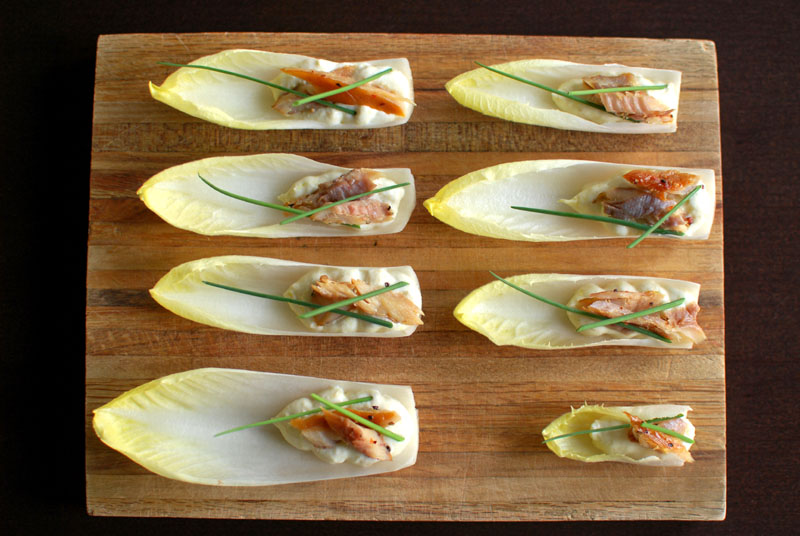
Not to mention that endive is a rather bitter green. Paired with other flavors, it’s lovely, but it’s a little much to just eat on its own. If you use the largest outermost leaves, your guests very well might only eat the end with the topping on it, and then leave the lipstick-stained bitter ends lying about.
Further, endive will not naturally sit flat on its spine. In order to achieve those picture-perfect platters, it’s necessary to shave off a tiny bit of the leaf from underneath, which is tedious and leaves you with a bunch of strange ellipsoid slivers lying about.
Two whole endives sacrificed their lives for six hors d’oeuvres, people. We can do better by them.
If your heart is set on using endive for an appetizer (or if you’ve already bought some), just do away with the “boat” idea completely. Forget it. It’s a trap. That way only leads to sadness. And though raw endive makes a fantastic salad, the French have a much better idea: cook it. Boil it, in fact.
It probably sounds like the least appealing thing in the world, but when boiled, endive loses its puckering bitterness, and a somehow nutty sweetness is coaxed from the leaves. It’s not much to look at, but it tastes fantastic. Ginette Mathiot, in her magnum opus I Know How to Cook, provides a recipe for endive purée that blends boiled endive with a quick béchamel sauce. Flavorful and simple, it’s so French it might as well be smoking.
Best of all, it’s a simple trick to turn this thick purée into an elegant canapé. Crustless white bread, lightly toasted and cut into triangles, makes a base for a dollop of the endive purée. A flake of smoked trout sits happily on top, accented with a colorful chive.
It’s nearly the same ingredients as the aforementioned endive bites, and just as attractive, but much better to eat and much nicer all around.

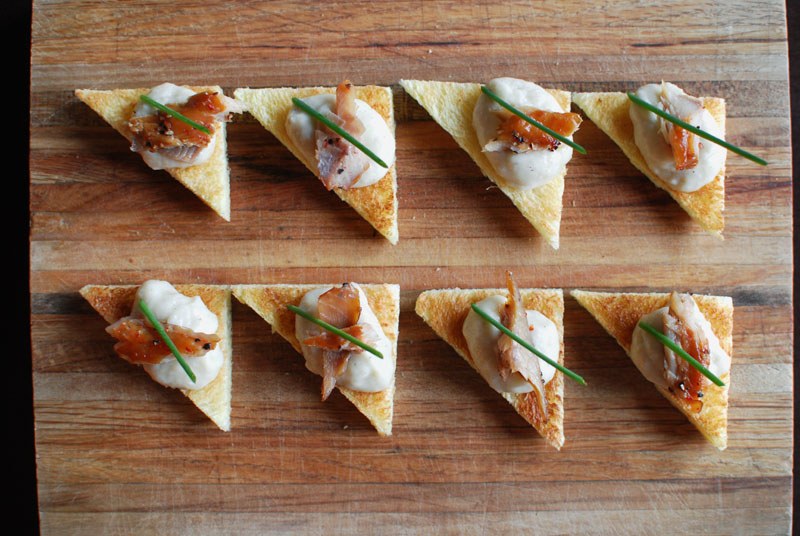
I’m not quite sure where all these endive boat recipes got started, but I’m reasonably sure it was from someone with too much time on his hands, too much endive in the fridge, or both. Maybe it’s some grand Endive Cabal, an alliance between endive farmers, recipe writers, and stylists, meant to make the rest of us poor saps look (and feel) dumb. As for me, I’m having no more of it, and I mean to convince you all as well. The next time you see one of these “endive boat” recipes, don’t pay it any attention. Just walk on by. You can thank me later.
Canapés with Endive Purée, Smoked Trout, and Chives
Makes about 2 cups purée, enough for many canapés
Adapted in part from I Know How to Cook, by Ginette Mathiot
The yield of this recipe is variable, but depends on how large your slices of bread are, how much smoked trout you have, and how many of these you feel like making (though it could hardly be described as difficult). You may end up with extra endive purée, which makes a fabulous sauce for pizza, especially with some slivered red onions and leftover smoked trout and chives on top. Just sayin’.
4 heads Belgian endive (about 1 1/4 pounds)
1 1/2 tablespoons butter
3 tablespoons all-purpose flour
1 cup milk
1/4 teaspoon freshly-grated nutmeg, or to taste
White pepper and salt, to taste
Sliced white sandwich bread
Melted butter or olive oil, as needed for brushing
Smoked trout, skin removed, and flaked
Fresh chives, snipped into 1 inch lengths
1. Preheat the broiler. Bring a medium pan of water to a boil over high heat. While heating water, cut endives into quarters lengthwise. Salt the boiling water liberally, and add the endives. Boil, uncovered, for 15 minutes.
2. While endives cook, make a béchamel sauce by melting the butter in a small saucepan over medium heat. When the foam subsides, whisk in the flour until thoroughly combined with the butter. Continue cooking and whisking until a slight nutty aroma develops, 2 to 3 minutes; do not let the mixture brown. Add the milk slowly, whisking to prevent lumps. Cook for 5 to 10 minutes, or until the béchamel is well thickened. Season to taste with the nutmeg, white pepper, and salt. Remove from heat.
3. After cooking the endive, drain well. Let cool briefly. When cool enough to handle, squeeze as much liquid as possible from the leaves, and transfer to a food processor.
4. Purée the boiled endive with the béchamel until smooth. Taste, and correct seasoning as needed with salt, white pepper, and nutmeg. Let cool. The purée should thicken a bit more as it cools.
5. While purée is cooling, prepare the bread. Brush each slice lightly with melted butter or olive oil. Toast under the hot broiler until just golden brown. Remove the crusts from the slices of bread, cut each slice into four triangles, and set aside. (At this point, check the consistency of the purée. It should be quite thick, and not at all runny. If it’s too thin, you can toss in some of the toasted bread crusts and process until well blended. Repeat as necessary.)
6. To finish canapés, top each bread triangle with a small dollop of the endive purée. Place a flake or two of smoked trout on top, and decorate with a piece of chive. Plate and serve immediately.

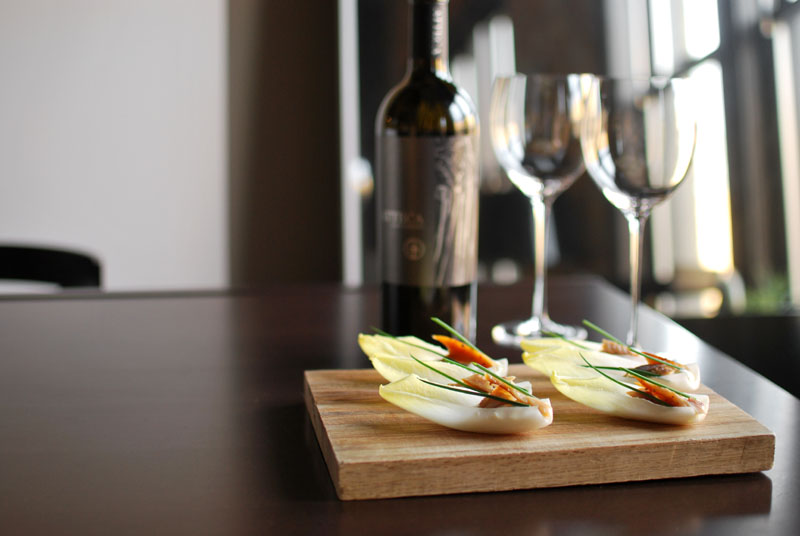
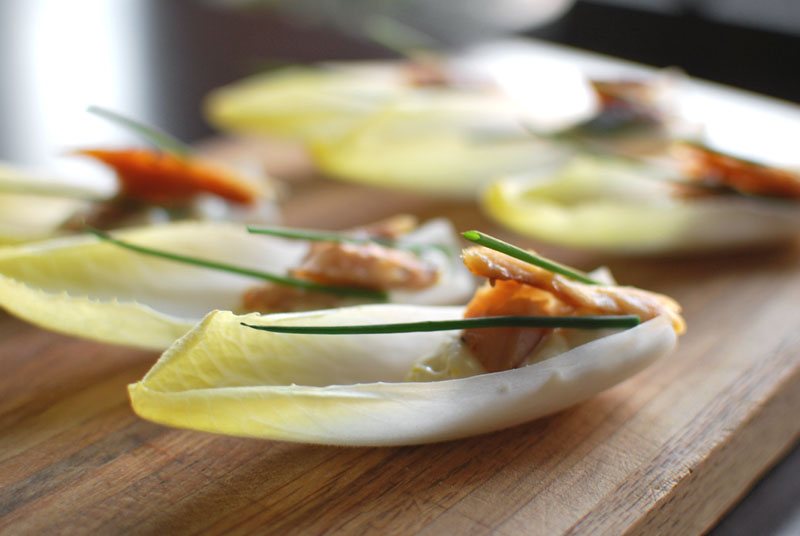
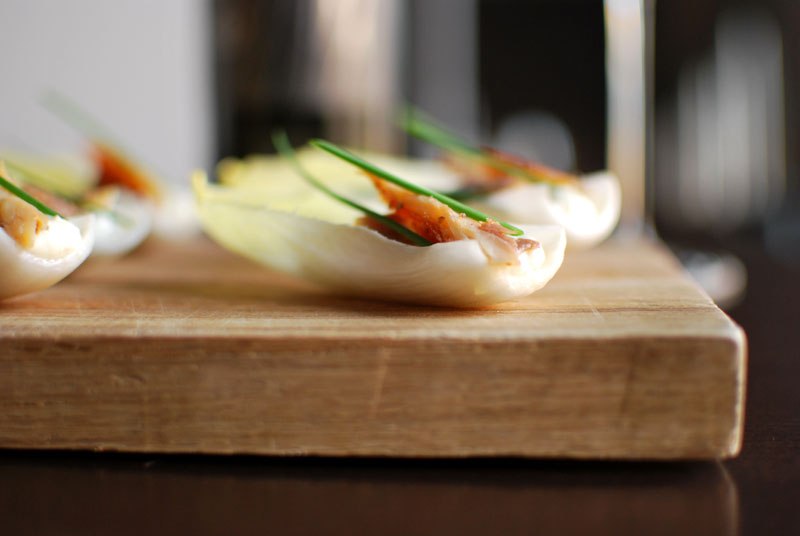
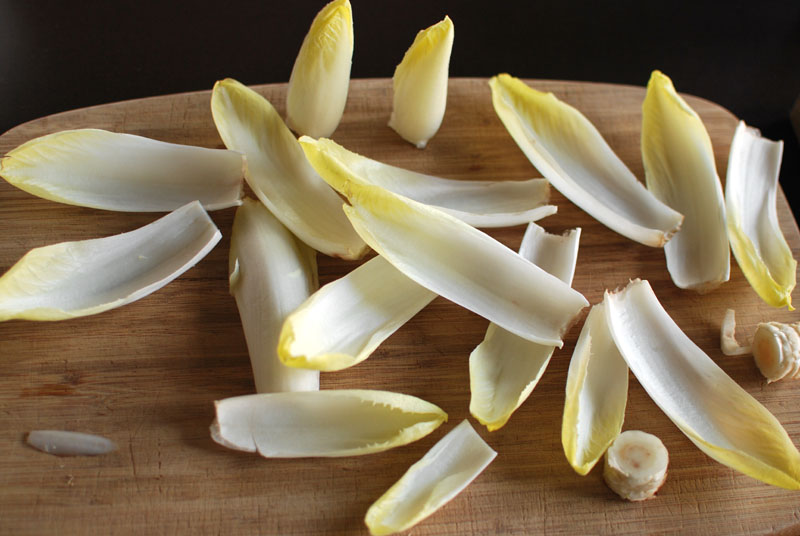

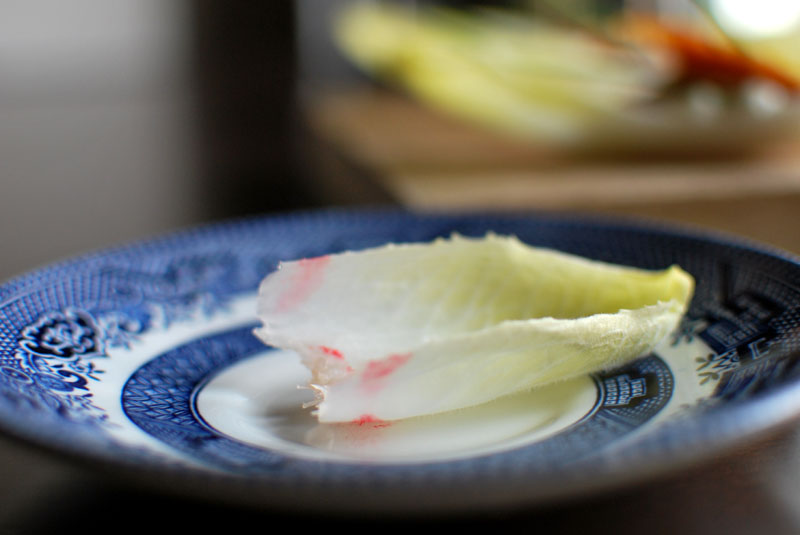



Great post! I love the expose — you’re so right, and what a fabulous solution.
The reason some of us have resorted to endive spears is because we can’t eat bread. The endless, endless, endless appetizer/dip recipes that call for bread are indigestible to some of us, not to mention over-filling and heavy. And one can only eat (and find new ways of serving) so many variations of crudités. And, here I thought I invented endive boats all by myself. How disappointing to discover they leave carnage in their wake!
CookiePie: Thank you! They’re as good to eat as they are to look at, too.
CEJH: Ah, yes, the gluten-free problem is another bag of worms altogether. I count my lucky stars that it’s not an issue I have to deal with on a daily basis, and my heart really goes out to those who do. But instead of endive boats, maybe try a crisp rice cracker in place of the bread? They’re quite light, and a perfect bite-size. Or maybe sliced cucumber rounds? If you want to get all Ferran Adriá, you could spread the endive purée out in a thin layer and bake in a low oven until dried out and crisp, and cut into “crackers”. (The flour in the béchamel would have to be replace with a g-f alternative.) Just thinking out loud!
I made the pizza with endive purée, shaved red onion, smoked trout, and chives using your pizza crust from your former site http://www.abreadaday.com/?p=2161 (an all-time favourite). I couldn’t think of a better combination that the one you mention, I just added some black Kalamata olives in strips and accompanied the pizza with a roasted beetroot salad with boiled eggs, dill and orange zest. Thank you so much Beth, you are always such an inspiration 🙂
Elisabeth: How cool! I bet the Kalamatas were fabulous on it. Also, please bring me some of that beet salad. That sounds amazing.
I agree that endive boats can be wasteful, but couldn’t you take all those odd sized pieces and a make the puree with them. I am a proponent of endive and other vegetable boats because my husband is gluten intolerant (celiac disease) and we have been to too many cocktail parties where there was nothing he could eat which is difficult when he is running from work and is starving when he gets there!
Kim: Absolutely; using the leftover scraps to make the purée would be a great way to use up the little bits. I have a good friend who is gluten-intolerant, so I completely understand the struggle. It’s still not on many people’s radar, unfortunately. Thank you for the suggestion!
I am sooo glad I found this expose while googling how many leaves are on a typical endive! I am in the middle of planning a catering event, and was fully planning on making an endive filled appetizer!!
I am going to take your recommendation and save myself hours of time and frustration and skip the endive as a holder, but I can’t wait to try the puree!!
Melissa: Yes! Fight the power! They’re sure pretty, but endive boats are NEVER worth the trouble. Good luck with your event!
Love the “expose”! 🙂 I do have another solution – when I make endive apps I arrange them in concentric circles on a large round platter, with smaller leaves in the center. It looks like a flower – and no waste! It’s even prettier if you alternate red and green endive leaves. The leaves that are way too big can be trimmed down at the base. And agreed the reason for using endives is to limit extra carbs / calories. Sometime you need a light app so guests don’t spoil their appetite for the meal ahead!
One could solve the flat bottom problem by serving them in a deviled egg dish.